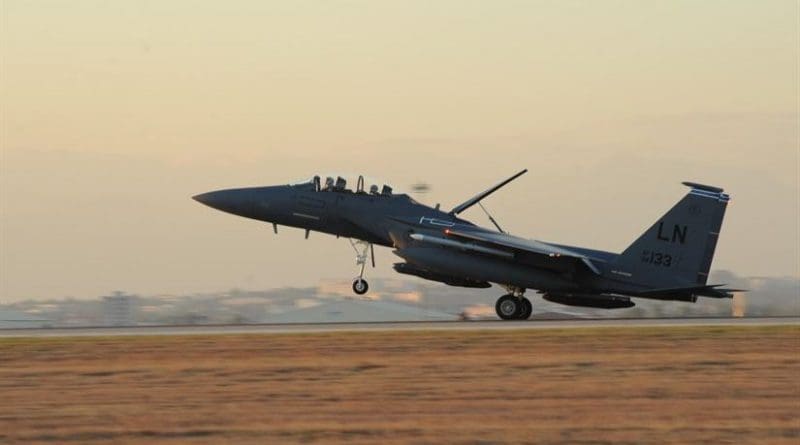NATO’s Largest Nuclear Storage Facility In Turkey Carries Risks – OpEd
By IDN
By Jonathan Power*
The Incirlik air base in southeast Turkey – from which U.S. pilots launch bombing raids on ISIS forces in Syria – is home to about 50 B-61 hydrogen bombs. That makes it NATO’s largest nuclear storage facility.
Each bomb has a yield of up to 170 kilotons, nearly a dozen times more powerful than the weapon that destroyed Hiroshima. The bombs are stored in underground vaults within aircraft shelters that in turn are protected by a security perimeter.
Recently, Incirlik was in the headlines because it appears it was one of the command centres of the attempted coup, meant to topple President Recep Tayyip Erdogan.
After the coup had been put down the commander of Incirlik was arrested and charged with complicity in the overthrow attempt.
Jonathan Marshall of Consortium News, who has been researching this year the inner workings of the base, reports: “The security of the bombs is premised on them being defended by loyal NATO forces. In the case of Incirlik that loyalty proved uncertain at best. Power to the base was cut after mutinous troops used a tanker plane from the base to refuel F-16s that menaced Ankara and Istanbul.”
He goes on in his latest report to observe, “One can easily imagine a clique of Islamist officers in a future coup seizing the nuclear bombs as a bargaining chip with Ankara and Washington or, worse yet, to support radical insurgents in the region.”
Jeffrey Lewis, a nuclear proliferation expert at the Middlebury Institute of International Studies at Monterey, asks, “Does it seem like a good idea to station American nuclear weapons at an air base commanded by someone who may have just helped bomb his own country’s presidential palace?”
Hans Kristensen, a nuclear expert with the Federation of American Scientists, argues that “the security situation in Turkey and in the base area no longer meet the safety requirements that the US should have for storage of nuclear weapons. You only get so many warnings before something goes terribly wrong. It’s time to withdraw the weapons”.
Most tellingly, former NATO Supreme Allied Commander James Stavridis wrote recently that if NATO really does house tactical nuclear weapons at Incirlik Air Base, “this poses a very dangerous problem”.
In April 2009 President Barack Obama, in front of an adoring crowd in Prague, spoke of his plans and dreams for a nuclear-free world. Years later he does not have that much to show for it. When Dimitri Medvedev was Russia’s president they did fashion an agreement that cut their armouries of intercontinental missiles by a substantial amount.
Even so, Obama in order to win the support necessary for ratification by Republicans in the Senate had to agree to a long-term one trillion dollar modernisation of America’s nuclear armoury. Obama has made no progress on curtailing short range “tactical” missiles based in Europe and Turkey. He has produced no rationale for keeping them or indeed those bombs stored at Incirlik.
Nevertheless, as his presidency winds to a close, Obama is preparing to challenge the Republican Congressional leaders and the heads of Senate Foreign Relations and Armed Services Committees. He is garnering wide support for his reported plan to implement at least a part of his Prague nuclear agenda through a series of executive actions.
U.S. Presidents have the right to make laws on their own say so. However, unlike a law legislated by Congress, a successor can simply nullify them. Obama apparently believes that Hillary Clinton would not overturn his actions, even though she is more hard-line than he is. (Donald Trump is another matter.)
The Washington Post reported on July 10 that executive options Obama are considering include declaring a “no first use” policy for the United States nuclear arsenal and a UN Security Council resolution affirming a ban on the testing of nuclear weapons as envisaged by the Comprehensive Test Ban Treaty (CTBT), which was conceived in the time of President John Kennedy but which Congress has long refused to ratify.
Obama is also considering offering Russia a five-year extension of the START treaty’s limits on deployed nuclear weapons, a delay in the development of a new nuclear cruise missile, called the Long-Range Stand-Off weapon, and cutting back long-term plans for modernizing the nation’s nuclear arsenal, which the Congressional Budget Office reports will cost about $350 billion over the next decade.
Certainly if this were done – and added to it the closing of the Incirlik nuclear armoury – Russian public opinion might start to take Obama seriously again. Even at this late stage President Vladimir Putin could be persuaded to take some initiatives of his own.
Indeed, a benign atmosphere might also make possible a solution to the Ukraine crisis. A running sore is the last thing Obama wants to leave behind.
This “ban the bomb” president should not leave office without having done what he said he would. [IDN-INPS – 26 July 2016]
Note: Jonathan Power syndicates his opinion articles. He forwarded this and his previous Viewpoints for publication in IDN-INPS. Copyright: Jonathan Power

